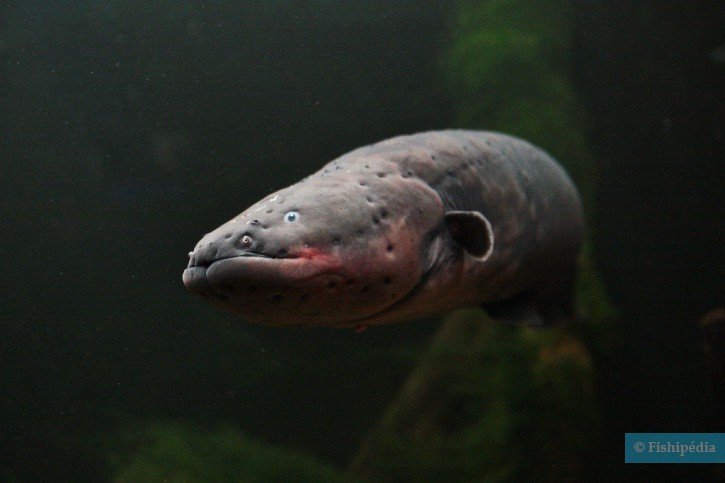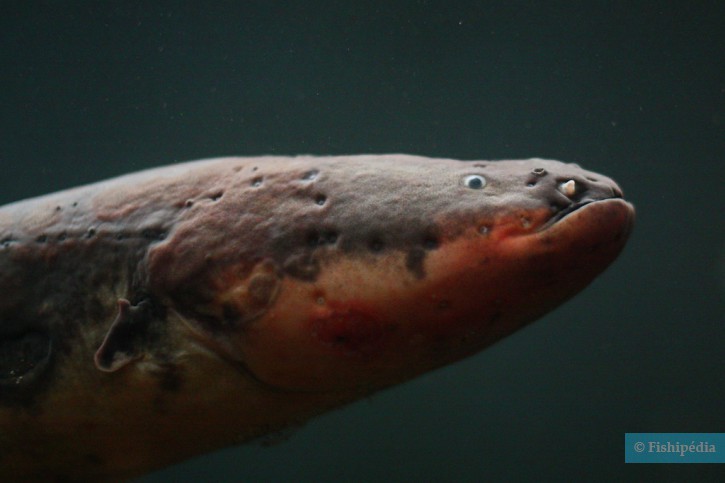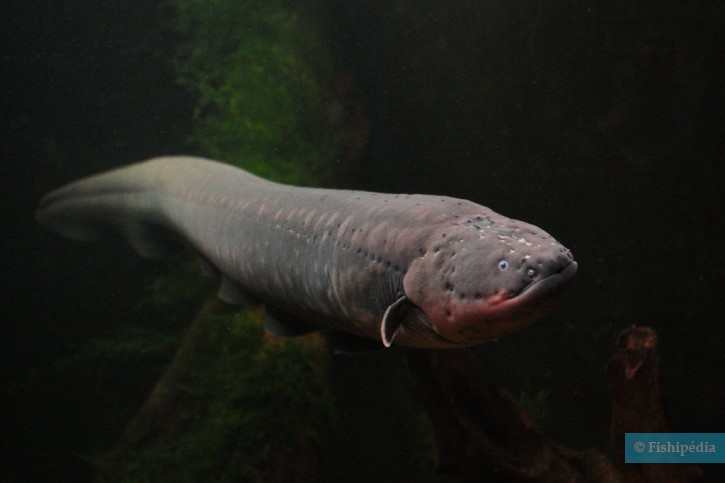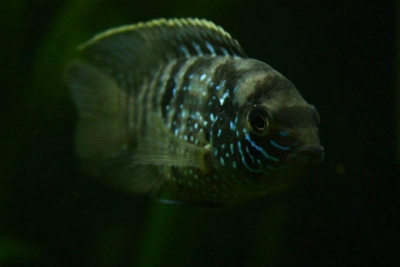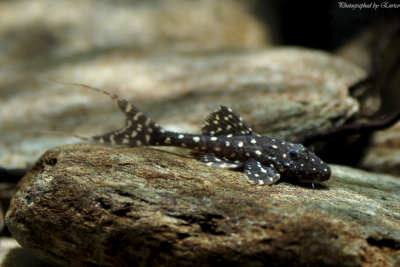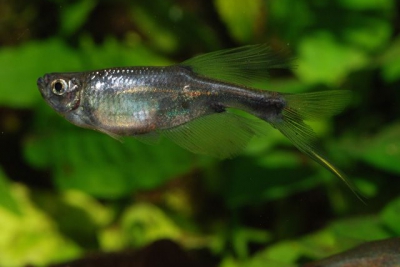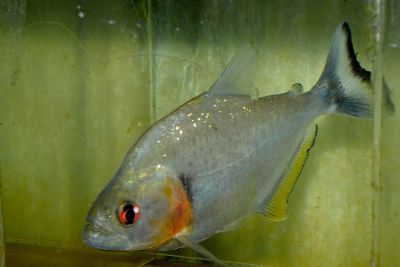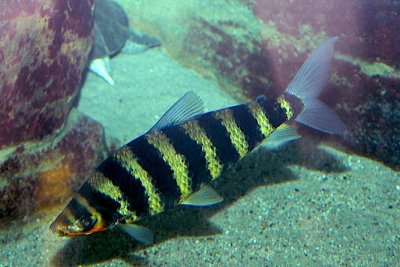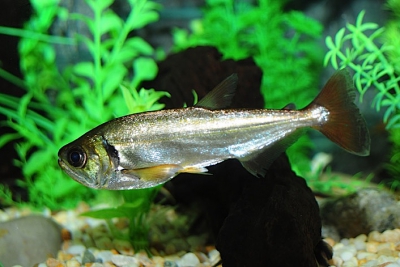electric eel
| Family | Gymnotidae |
|---|---|
| Genus | Electrophorus |
| IUCN category (World) | LC |


Introduction
The electric eel is a freshwater fish from South America found in the basins of the Amazon and Orinoco rivers. Like all species in the Gymnotidae family, it has the ability to emit electric impulses.
These animals have been studied since the 18th century and have inspired numerous research projects, such as Alessandro Volta's battery, the regularity of impulse frequencies studied at the Nancy Aquarium Museum, and in 2017, the development of hydrogels used in pacemakers.
Who is it?
Morphology
-
Type
-
Average size200 cm
-
Maximum size250 cm
-
ShapeSerpentiform
-
Type
-
Average size200 cm
-
Maximum size250 cm
-
ShapeSerpentiform
How to recognize This fish ?
This eel-like fish, 2 to 2.5 meters long, is brown/green with a white/yellow to orange belly. It does not have caudal, dorsal, or pectoral fins. The anal fin is long.
Although the species has gills, it also breathes through its mouth. The mouth is highly vascularized, facilitating gas exchange. To breathe in poorly oxygenated areas, the electric eel surfaces to "gulp" air. This characteristic allows the electric eel to move on land and inhabit low-oxygen dead river branches.
The electric eel emits electric discharges thanks to modified muscles at the back of its body. It is also capable of analyzing an electric field through receptors located under its head.
The modified muscle cells, also called electrocytes, generate a current that can exceed 700 volts at 2 amperes. This discharge is sufficient to stun a large prey.
This ability also serves for electrolocation: the electric eel can navigate in murky waters thanks to the electric field it emits.
Sexual dimorphism
There is no sexual dimorphism in this species. However, adult males are larger than females.
Behaviour & Life cycle
-
dietcarnivorous
-
Sociabilitysolitary
-
territorialNo
-
Way of livingdiurnal
The electric eel is mainly nocturnal. Like most electric fish, it creates an electric field around itself that allows it to determine the nature of objects around it. A animal or object will modify this electric field by its charge, giving the electric eel information about its environment.
Electrophorus electricus is an active hunter. When prey is detected, the animal approaches and emits an electric discharge that stuns the prey. The prey is then ingested by the electric eel. Adults are piscivores and juveniles feed on invertebrates.
We count 3 types of possible discharges in this fish: a low voltage impulse for electrolocation, high voltage impulses for hunting, and high voltage and high frequency impulses for prey capture and defense.
It is not uncommon for individuals to leap out of the water to attack prey or defend themselves. Kenneth Catania, from Vanderbilt University, observed that this action intensifies the voltage.
Reproduction
The dry season, between September and December, marks the start of the breeding season. The male creates a nest covered with mucus along the banks by digging into the mud. The female then deposits around ten thousand eggs which the male fertilizes. The male then guards the eggs and larvae until the first mid-January rains arrive. The approximately 10 cm long juveniles are then dispersed by the now stronger currents.
The first hatching larvae exhibit cannibalistic behavior towards the eggs and other larvae that hatch later. On average, only about a thousand larvae develop until the rainy season. Electric discharges can be produced as early as 1.5 centimeters.
Life-threatening species
-
VenomousNo
-
ElectrocuteYes
Although the voltage and amperage are not always enough to kill a healthy person, the electric discharge of an adult electric eel can cause a fainting spell followed by drowning, respiratory arrest, or a heart attack for the victim. This shock can be fatal for individuals with heart conditions.
Origin and distribution
What is its habitat?
Natural environment characteristics
Biotope presentation
The electric eel generally inhabits shallow areas with muddy bottoms. This species can also be found in other areas of the rivers and streams of the Amazon and Orinoco basins.
Species of the same biotope
Fishkeeping
Not recommended
We do not recommend keeping this species in an aquarium. It has unpredictable needs which, if not met, generate significant stress, potentially leading to a shorter life expectancy, an interruption of its growth or the development of pathogens.
To go further
Sources & Contributions
Participation & Validation
The Fishipedia team and specialist contributors are committed to providing high-quality content. However, although the information comes from scientific sources or testimonials from specialists, the cards may contain inaccuracies.
Translation
Translation done with the valuable contribution of our translators, who make this information available to a wider audience. We sincerely thank them for their commitment.
Bibliographic references
- - GBIF
- - Gas exchange and control of breathing in the electric eel, Electrophorus electricushttps://doi.org/10.1007/BF00341112 - Kjell Johansen, Claude Lenfant, Knut Schmidt-Nielsen & Jorge A. Petersen - - 1968. Zeitschrift für vergleichende Physiologie volume
Scientific partners
Species of the same biotope




